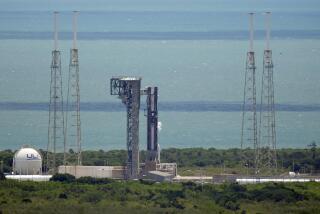Electrical Trouble Aboard Shuttle Delays Tracking Test
- Share via
KENNEDY SPACE CENTER, Fla. — Electrical problems prevented astronauts aboard the shuttle Discovery from shooting six metal balls into orbit Friday, and ground controllers scrambled to salvage the space-tracking experiment.
National Aeronautics and Space Administration officials said they hope to resolve the trouble by the next release opportunity Sunday.
Astronaut Michael Clifford was minutes away from ejecting the balls from a can in the shuttle cargo bay when he found that he was getting bad signals through the deploy-mechanism electronics.
The five crew members tried plugging in the hand-held controller somewhere else, swapped out batteries and double-checked switch positions, but still failed to receive the desired electrical readouts. Mission Control scrapped the test and assembled a special team to study the problem.
Clifford said that a visual inspection of the cables around the ball-filled can showed everything to be in proper order.
Researchers designed the balls so that they could be tracked easily by radar and telescopes. Two are two inches in diameter and two are four inches in diameter, and are made of stainless steel. Two that are six inches in diameter are made of aluminum.
The researchers want to track the balls so that they can fine-tune their instruments and get more experience tracking small objects in space. A two-inch object is the smallest thing that can be tracked by many radar stations in the U.S. Space Command system, NASA orbital debris scientist Eugene Stansbery said.
The U.S. Space Command is tracking about 7,000 objects in orbit, most of it junk: spent rockets, dead satellites and fragments from exploded boosters. Even the smallest objects can do major damage upon impact, given the average orbital speed of 17,500 m.p.h.
Discovery’s astronauts also had little luck with a laser experiment Friday, their third day in space.
They installed a fresh battery in the Army laser receiver on board after failing to pick up signals beamed from an Air Force facility in Palm Bay, Fla., 201 miles below.
The crew later got “the tiniest little burst” of what might be laser data when signals were beamed from an Air Force site on the Hawaiian island of Maui, shuttle commander David Walker said.
Researchers believe that cloudy weather prevented laser signals from reaching Discovery on Thursday. The sky over Maui was mostly clear during Friday’s test.
More to Read
Sign up for Essential California
The most important California stories and recommendations in your inbox every morning.
You may occasionally receive promotional content from the Los Angeles Times.













